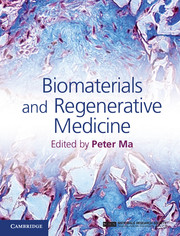Book contents
- Frontmatter
- Contents
- List of contributors
- Preface
- Part I Introduction to stem cells and regenerative medicine
- Part II Porous scaffolds for regenerative medicine
- Part III Hydrogel scaffolds for regenerative medicine
- 14 Polysaccharide hydrogels for regenerative medicine applications
- 15 Functionalized poly(ethylene glycol) hydrogels for controlling stem cell fate
- 16 Fumarate-based hydrogels in regenerative medicine applications
- 17 Hydrogel scaffolds for regenerative medicine
- 18 Microfabricated gels for tissue engineering
- 19 Organ printing
- Part IV Biological factor delivery
- Part V Animal models and clinical applications
- Index
- References
18 - Microfabricated gels for tissue engineering
from Part III - Hydrogel scaffolds for regenerative medicine
Published online by Cambridge University Press: 05 February 2015
- Frontmatter
- Contents
- List of contributors
- Preface
- Part I Introduction to stem cells and regenerative medicine
- Part II Porous scaffolds for regenerative medicine
- Part III Hydrogel scaffolds for regenerative medicine
- 14 Polysaccharide hydrogels for regenerative medicine applications
- 15 Functionalized poly(ethylene glycol) hydrogels for controlling stem cell fate
- 16 Fumarate-based hydrogels in regenerative medicine applications
- 17 Hydrogel scaffolds for regenerative medicine
- 18 Microfabricated gels for tissue engineering
- 19 Organ printing
- Part IV Biological factor delivery
- Part V Animal models and clinical applications
- Index
- References
Summary
Introduction
Tissue engineering aims to develop biological substitutes that repair or replace damaged tissues or whole organs by combining technologies from engineering and medical sciences [1]. Although tissue engineering has enabled successful generation of various artificial tissue substitutes, such as skin [2], bladder [3], cartilage [4], bone [5], heart valves [6], and blood vessels [7], a number of challenges remain to be solved. It has been challenging to engineer large and vascularized organs such as the heart or liver. These tissues depend on adequate vascularization for the supply of nutrients and oxygen. In tissue engineering, this translates into not only creating the specific tissue but also making the highly organized vasculature. On the other hand, avascular tissues such as heart valves or cartilage depend on adequate diffusion for their supply of nutrients and oxygen. In terms of engineering, an avascular biomimetic construct cannot be too thick [8, 9], since this would lead to a limited supply of nutrients and oxygen [1]. Microfabrication strategies aim to overcome these limitations by controlling the size, geometry and features of three-dimensional (3D) in-vitro tissue-engineered constructs. Recent advances in biomaterials combined with developments in microengineering methods have enabled the development of vascular networks, prevascularized tissue constructs, and creation of well-ordered tissue constructs from microgel units with different cell types. [10].
Native tissues consist of cells that reside in a framework called the extracellular matrix (ECM). The ECM is composed of proteins (e.g. collagen), fibers (e.g. elastin), polysaccharides (e.g. hyaluronic acid), glycosaminoglycans (e.g. heparan sulfate), and growth factors (e.g. fibroblast growth factor). The ECM functions as a support system for cells to exert their biological function and can be viewed as the scaffolding environment for the tissues. Traditional tissue engineering uses synthetic scaffolds or biomaterials as molds to create tissue constructs. These scaffolds are typically porous, biocompatible, and degradable, and allow sufficient diffusion to occur [11]. Furthermore, such scaffolds enable cell adhesion, proliferation, and differentation, and tissue organization that are similar to those in their native counterparts [12]. Over time, the synthetic scaffold will degrade in vivo, while the cells deposit new natural scaffolding (ECM), thus leading to the formation of new tissue.
- Type
- Chapter
- Information
- Biomaterials and Regenerative Medicine , pp. 317 - 331Publisher: Cambridge University PressPrint publication year: 2014



